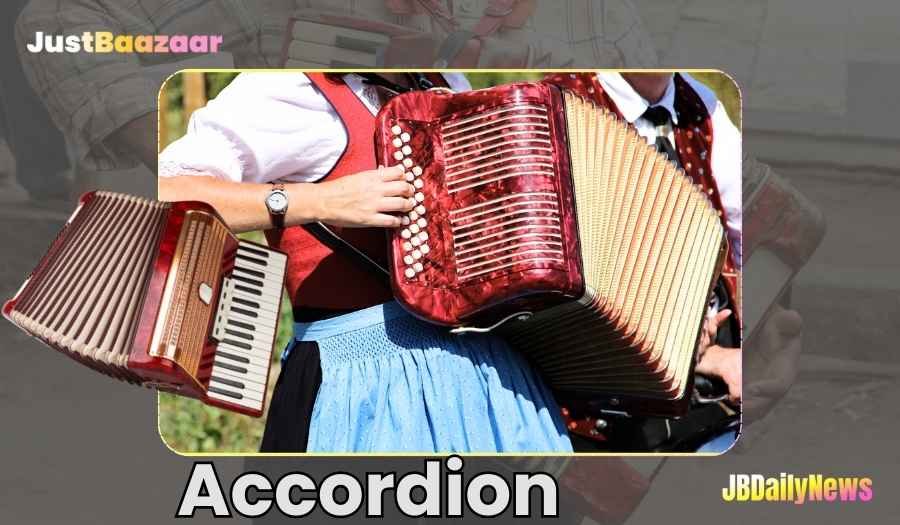The accordion is a unique and versatile musical instrument known for its distinct sound, iconic bellows, and captivating design. Popular in many musical genres, it remains celebrated worldwide for its expressiveness and emotional range. This guide delves into the accordion’s mechanics, history, uses, and even the various ways it’s referenced beyond music, including in HTML.

1. How the Accordion Works
The accordion is a bellows-driven free reed aerophone. It produces sound as air flows through metal reeds, which vibrate when the bellows are expanded or compressed. Here’s a closer look at its key components:
- Bellows: The heart of the accordion, the bellows push air through the reeds, creating sound. By expanding or compressing, the musician can change the airflow and, thus, the dynamics of the sound.
- Keyboards: The accordion usually has two sets of keyboards or button boards:
- Right Side (Melody Keyboard): Either a piano keyboard or a button keyboard, this side is used to play the melody.
- Left Side (Bass Keyboard): The left keyboard often consists of buttons for chords and bass notes, allowing the musician to accompany the melody with harmonies or rhythmic patterns.
- Reeds: Small metal strips inside the accordion, which produce sound when air passes over them. Each reed vibrates at a specific pitch, giving the accordion its characteristic tone.
2. Accordion Keyboards
Accordions come with various keyboard layouts:
- Piano Accordion: Features a piano-style keyboard on the right side, with keys for melody notes. This style is common in Western music.
- Button Accordion: Popular in folk and traditional music, this type has a button keyboard on both sides, allowing more notes in a smaller space.
Each type requires different techniques but both offer a broad range of notes and chords.
3. The History of the Accordion
The accordion’s journey began in Europe in the early 19th century and rapidly spread due to its portability and expressive sound:
- Early Development: Invented in Vienna, Austria, in 1829 by Cyril Demian, the accordion’s design was relatively simple, with a few buttons and basic functionality.
- Growth in Popularity: By the late 19th century, it had become popular across Europe, North America, and Latin America. In particular, it thrived in folk and regional music, from French musette to Mexican norteño.
- Global Influence: In the 20th century, the accordion became central in tango music in Argentina, zydeco in Louisiana, and polka across Europe. Each region adapted the instrument to its unique style, giving it a truly global identity.
4. Uses of the Accordion
The accordion is widely used across multiple genres, from folk to pop music. Its versatility makes it suitable for:
- Folk and Traditional Music: Often seen in genres like Celtic, polka, and Cajun music.
- Latin American Music: Central in styles like tango and norteño.
- Classical Music: Composers have written concertos and pieces for the accordion.
- Modern and Popular Music: Recently, the accordion has found its place in pop and alternative genres, offering a nostalgic or exotic sound.
5. Accordion as an Adjective: “Accordion-Like”
The term “accordion-like” is used to describe anything that expands and contracts or has a folding structure similar to an accordion. For instance:
- “The accordion-like folds of the brochure made it compact yet informative.”
- “Her accordion-like laughter echoed in the hall, rising and falling in waves.”
6. Accordion as a Word: Pronunciation, Spelling, and Etymology
- Pronunciation: The accordion is pronounced /əˈkɔːr.di.ən/.
- Spelling: A-c-c-o-r-d-i-o-n.
- Etymology: The term derives from the German word “Akkordeon,” related to “Akkord” (meaning harmony or agreement).
7. The Accordion Family
Accordions belong to a family of box-shaped, free-reed aerophones which includes several other instruments that use bellows and reeds. These instruments share similar mechanics but vary in structure, key layouts, and musical style.
8. The Accordion in HTML
In web development, an “accordion” refers to a collapsible UI pattern often used to organize large amounts of content in a compact, easy-to-navigate format:
- How It Works in HTML: An HTML accordion hides or shows sections of content as a user clicks on headers or tabs. Common in FAQs or navigation menus, it simplifies the layout and enhances user experience.
9. Is the Accordion Difficult to Play?
The accordion can be challenging due to its multitasking demands:
- Coordination: Playing requires synchronizing both hands while managing bellows pressure.
- Technique Mastery: Learning to control bellows movement, especially for dynamic expression, can take time.
However, like most instruments, consistent practice makes it manageable, and once mastered, the accordion becomes incredibly expressive.
10. Is the Accordion Like a Harmonica?
While the accordion and harmonica share the same free reed mechanism, they differ greatly:
- Accordion: Played with both hands and uses bellows to push air.
- Harmonica: Held in the hands and relies on the musician’s breath to control airflow.
11. Country of Origin
The accordion was invented in Austria in 1829 by Cyril Demian. Since then, it has been embraced globally and modified in various ways to fit local music styles.
Conclusion: The accordion, with its rich history and unique design, continues to charm audiences worldwide. Whether in folk dances or modern pop, it adapts to any genre, making it an enduring and beloved instrument.
